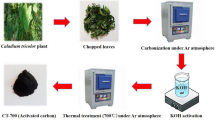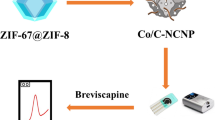Abstract
A carbon paste electrode (CPE) modified with a metal-organic framework composite of type MIL-101(Fe) is described for determination of citric acid (CA). The electrochemical activity of the modified CPE was studied by cyclic voltammetry and differential pulse voltammetry. Scanning electron microscopy, Fourier transform infrared spectroscopy, X-ray photoelectron spectroscopy, N2 adsorption-desorption isotherms and X-ray powder diffraction were used for characterization of the MIL-101(Fe). Under optimized electrochemical conditions, the anodic peak current, best measured at working potentials around 0.02 V (vs. Ag/AgCl); decreases linearly in the 5.0 to 100 μM CA concentration range, and the detection limit is 4.0 μM (at S/N = 3). The electrode exhibits good selectivity for CA, with no significant interference in the wide pH range of 3.0 to 9.0. The electrochemical sensitivity of the MIL-CPE is −0.67 μA·μM−1·cm−2. The method was successfully applied to the determination of CA in some commercial beverages. The good recoveries (98–102%) and the agreement of data with those obtained by HPLC indicate the applicability of the method.

Schematic presentation of a new modified carbon paste electrode based on the metal-organic framework of type MIL-101(Fe) for the simple and sensitive determination of citric acid. The results show the MIL-101(Fe)-modified electrode to have good selectivity for citric acid and to enable real sample analysis.




Similar content being viewed by others
References
Farha OK, Hupp JT (2010) Rational design, synthesis, purification, and activation of metal− organic framework materials. Acc Chem Res 43(8):1166–1175. https://doi.org/10.1021/ar1000617
Sumida K, Rogow DL, Mason JA, McDonald TM, Bloch ED, Herm ZR, Bae T-H, Long JR (2011) Carbon dioxide capture in metal–organic frameworks. Chem Rev 112(2):724–781. https://doi.org/10.1021/cr2003272
Aijaz A, Karkamkar A, Choi YJ, Tsumori N, Rönnebro E, Autrey T, Shioyama H, Xu Q (2012) Immobilizing highly catalytically active Pt nanoparticles inside the pores of metal–organic framework: a double solvents approach. J Am Chem Soc 134(34):13926–13929. https://doi.org/10.1021/ja3043905
Horcajada P, Gref R, Baati T, Allan PK, Maurin G, Couvreur P, Ferey G, Morris RE, Serre C (2011) Metal–organic frameworks in biomedicine. Chem Rev 112(2):1232–1268. https://doi.org/10.1021/cr200256v
Fernandes DM, Granadeiro CM, Paes de Sousa PM, Grazina R, Moura JJ, Silva P, Paz A, Filipe A, Cunha-Silva L, Balula SS (2014) SiW11Fe@ MIL-101 (Cr) composite: a novel and versatile Electrocatalyst. ChemElectroChem 1(8):1293–1300. https://doi.org/10.1002/celc.201402224
Han S, Wei Y, Valente C, Lagzi I, Gassensmith JJ, Coskun A, Stoddart JF, Grzybowski BA (2010) Chromatography in a single metal− organic framework (MOF) crystal. J Am Chem Soc 132(46):16358–16361. https://doi.org/10.1021/ja1074322
Cui Y, Yue Y, Qian G, Chen B (2011) Luminescent functional metal–organic frameworks. Chem Rev 112(2):1126–1162. https://doi.org/10.1021/cr200101d
Taylor-Pashow KM, Della Rocca J, Xie Z, Tran S, Lin W (2009) Postsynthetic modifications of iron-carboxylate nanoscale metal− organic frameworks for imaging and drug delivery. J Am Chem Soc 131(40):14261–14263. https://doi.org/10.1021/ja906198y
Scherb C, Williams JJ, Hinterholzinger F, Bauer S, Stock N, Bein T (2011) Implementing chemical functionality into oriented films of metal–organic frameworks on self-assembled monolayers. J Mater Chem 21(38):14849–14856. https://doi.org/10.1039/c0jm04526h
Čendak T, ŽunkoviČ E, Godec TU, Mazaj M, Logar NZ, Mali G (2014) Indomethacin embedded into MIL-101 frameworks: a solid-state NMR study. J Phys Chem C 118(12):6140–6150. https://doi.org/10.1021/jp412566p
Zhang Z, Li X, Liu B, Zhao Q, Chen G (2016) Hexagonal microspindle of NH 2-MIL-101 (Fe) metal–organic frameworks with visible-light-induced photocatalytic activity for the degradation of toluene. RSC Adv 6(6):4289–4295. https://doi.org/10.1039/c5ra23154j
Wu B, Liang G, Lin X, Wu L, Luo J, Xu T (2014) Immobilization of N-(3-aminopropyl)-imidazole through MOFs in proton conductive membrane for elevated temperature anhydrous applications. J Membr Sci 458:86–95. https://doi.org/10.1016/j.memsci.2014.01.059
Horcajada P, Chalati T, Serre C, Gillet B, Sebrie C, Baati T, Eubank JF, Heurtaux D, Clayette P, Kreuz C (2010) Porous metal–organic-framework nanoscale carriers as a potential platform for drug delivery and imaging. Nat Mater 9(2):172–178. https://doi.org/10.1038/nmat2608
Dhakshinamoorthy A, Alvaro M, Garcia H (2010) Metal organic frameworks as solid acid catalysts for acetalization of aldehydes with methanol. Adv Synth Catal 352(17):3022–3030. https://doi.org/10.1002/adsc.201000537
Carbó AD (2009) Electrochemistry of porous materials. Chromatographia 72:1247. https://doi.org/10.1365/s10337-010-1748-x
Lin H, Wang X, Hu H, Chen B, Liu G (2009) A novel copper (II) complex constructed with mixed ligands of biphenyl-4, 4′-dicarboxylic acid (H 2 bpdc) and dipyrido [3, 2-d: 2′, 3′-f] quinoxaline (Dpq): synthesis, structure, electrochemistry and electrocatalysis. Solid State Sci 11(3):643–650. https://doi.org/10.1016/j.solidstatesciences.2008.10.007
Nguyen TLA, Devic T, Mialane P, Riviere E, Sonnauer A, Stock N, Demir-Cakan R, Morcrette M, Livage C, Marrot J (2010) Reinvestigation of the MII (M= Ni, co)/TetraThiafulvaleneTetraCarboxylate system using high-throughput methods: isolation of a molecular complex and its single-crystal-to-single-crystal transformation to a two-dimensional coordination polymer. Inorg Chem 49(22):10710–10717. https://doi.org/10.1021/ic101906u
Qin Y-R, Zhu Q-Y, Huo L-B, Shi Z, Bian G-Q, Dai J (2010) Tetrathiafulvalene− Tetracarboxylate: an intriguing building block with versatility in coordination structures and redox properties. Inorg Chem 49(16):7372–7381. https://doi.org/10.1021/ic100546r
Kachoosangi RT, Wildgoose GG, Compton RG (2007) Room temperature ionic liquid carbon nanotube paste electrodes: overcoming large capacitive currents using rotating disk electrodes. Electroanalysis 19(14):1483–1489. https://doi.org/10.1002/elan.200703883
Penniston KL, Nakada SY, Holmes RP, Assimos DG (2008) Quantitative assessment of citric acid in lemon juice, lime juice, and commercially-available fruit juice products. J Endourol 22(3):567–570. https://doi.org/10.1089/end.2007.0304
Brul S, Coote P (1999) Preservative agents in foods: mode of action and microbial resistance mechanisms. Int J Food Microbiol 50(1–2):1–17. https://doi.org/10.1016/s0168-1605(99)00072-0
Lima LL, Schuler A, Guerra NB, Pereira GE, Lima TL, Rocha H (2010) Optimization and validation method for organic acid determination in wines by high performance liquid cromatography. Quim Nova 33(5):1186–1189. https://doi.org/10.1590/s0100-40422010000500032
Yebra M, Cespon R (1999) Indirect atomic absorption spectrometric determination of citric acid by continuous precipitation. Fresenius J Anal Chem 365(4):370–373. https://doi.org/10.1007/s002160051503
Luque-Pérez E, Rı́os A, Valcárcel M (1998) Flow-injection spectrophotometric determination of citric acid in beverages based on a photochemical reaction. Anal Chim Acta 366(1–3):231–240. https://doi.org/10.1016/s0003-2670(98)00110-x
do Nascimento RF, Selva TMG, Ribeiro WF, Belian MF, Angnes L, do Nascimento VB (2013) Flow-injection electrochemical determination of citric acid using a cobalt (II)–phthalocyanine modified carbon paste electrode. Talanta 105:354–359. https://doi.org/10.1016/j.talanta.2012.10.055
Skobelev IY, Sorokin AB, Kovalenko KA, Fedin VP, Kholdeeva OA (2013) Solvent-free allylic oxidation of alkenes with O2 mediated by Fe-and Cr-MIL-101. J Catal 298:61–69. https://doi.org/10.1016/j.jcat.2012.11.003
Wang D, Huang R, Liu W, Sun D, Li Z (2014) Fe-based MOFs for photocatalytic CO2 reduction: role of coordination unsaturated sites and dual excitation pathways. ACS Catal 4(12):4254–4260. https://doi.org/10.1021/cs501169t
Fernandes DM, Barbosa AD, Jo P, Balula SS, Cunha-Silva L, Freire C (2013) Novel composite material polyoxovanadate@ MIL-101 (Cr): a highly efficient electrocatalyst for ascorbic acid oxidation. ACS Appl Mater Interfaces 5(24):13382–13390. https://doi.org/10.1021/am4042564
Araújo CL, Melo EI, Coelho NM (2011) Potentiometric detection of citrate in beverages using a graphite carbon electrode. Talanta 84(4):1169–1173. https://doi.org/10.1016/j.talanta.2011.03.027
Zakharova EA, Moskaleva M, Akeneev YA, Moiseeva E, Slepchenko GB, Pikula NP (2011) Potentiometric determination of the total acidity and concentration of citric acid in wines. J Anal Chem 66(9):848–853. https://doi.org/10.1134/s1061934811090218
Honeychurch KC, Gilbert L, Hart JP (2010) Electrocatalytic behaviour of citric acid at a cobalt phthalocyanine-modified screen-printed carbon electrode and its application in pharmaceutical and food analysis. Anal Bioanal Chem 396(8):3103–3111. https://doi.org/10.1007/s00216-010-3534-x
Themelis DG, Tzanavaras PD (2001) Reagent-injection spectrophotometric determination of citric acid in beverages and pharmaceutical formulations based on its inhibitory effect on the iron (III) catalytic oxidation of 2, 4-diaminophenol by hydrogen peroxide. Anal Chim Acta 428(1):23–30. https://doi.org/10.1016/s0003-2670(00)01221-6
Capitán-Vallvey LF, Arroyo-Guerrero E, Fernández-Ramos MD, Santoyo-González F (2005) Development of a one-shot optical citrate sensor based on a guanidinium synthetic receptor. Microchim Acta 151(1–2):93–100. https://doi.org/10.1007/s00604-005-0378-8
Ghassempour A, Najafi NM, Amiri AA (2003) Determination of citric acid in fermentation media by pyrolysis mass spectrometry. J Anal Appl Pyrolysis 70(2):251–261. https://doi.org/10.1016/s0165-2370(02)00135-3
Acknowledgments
The authors express their gratitude to Shiraz University Research Council for the support of this work (grant no. 95GCU2M172254).
Author information
Authors and Affiliations
Corresponding author
Ethics declarations
The author(s) declare that they have no competing interests.
Additional information
Publisher’s note
Springer Nature remains neutral with regard to jurisdictional claims in published maps and institutional affiliations.
Electronic supplementary material
ESM 1
(DOCX 301 kb)
Rights and permissions
About this article
Cite this article
Valizadeh, H., Tashkhourian, J. & Abbaspour, A. A carbon paste electrode modified with a metal-organic framework of type MIL-101(Fe) for voltammetric determination of citric acid. Microchim Acta 186, 455 (2019). https://doi.org/10.1007/s00604-019-3585-4
Received:
Accepted:
Published:
DOI: https://doi.org/10.1007/s00604-019-3585-4




